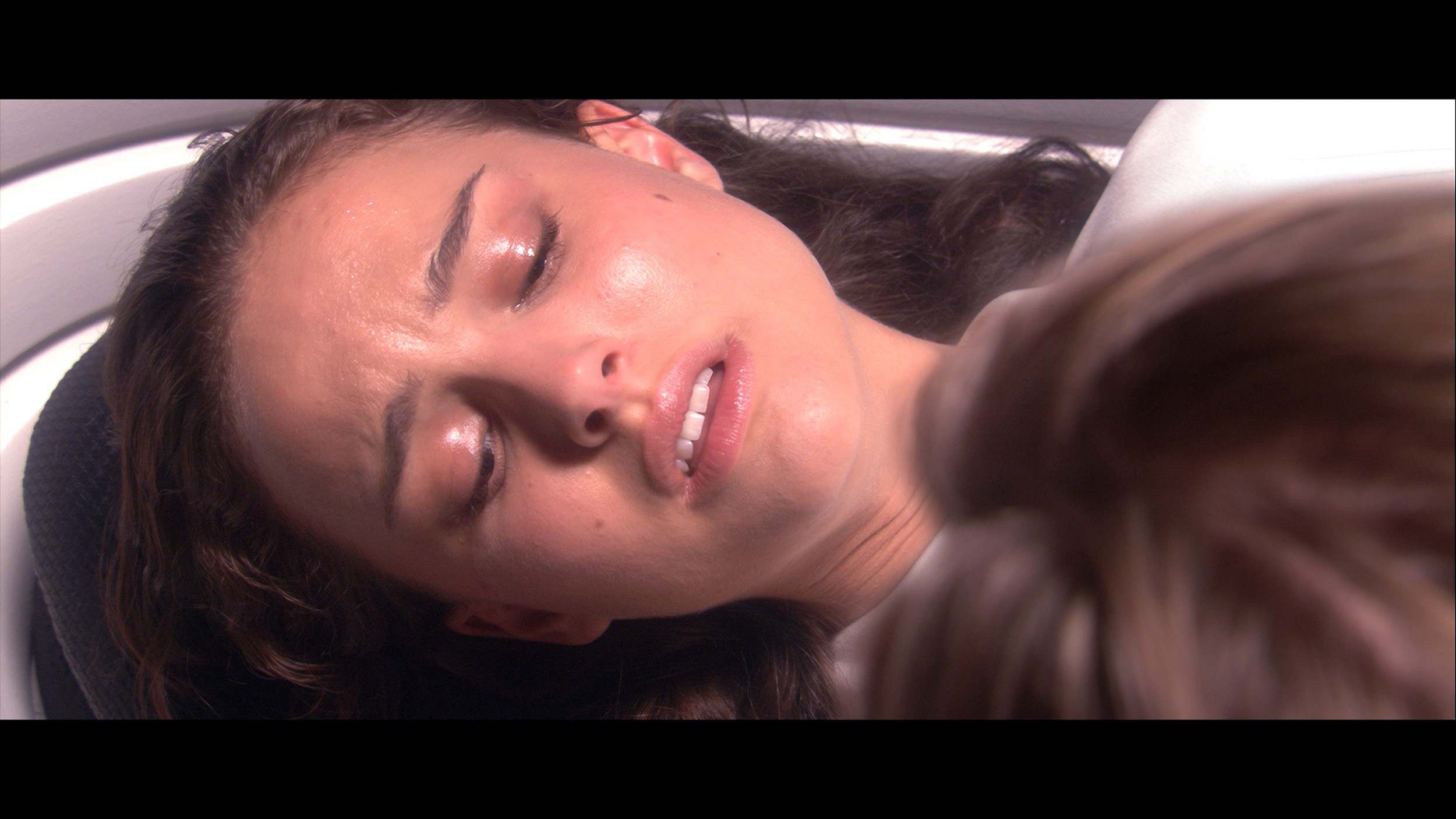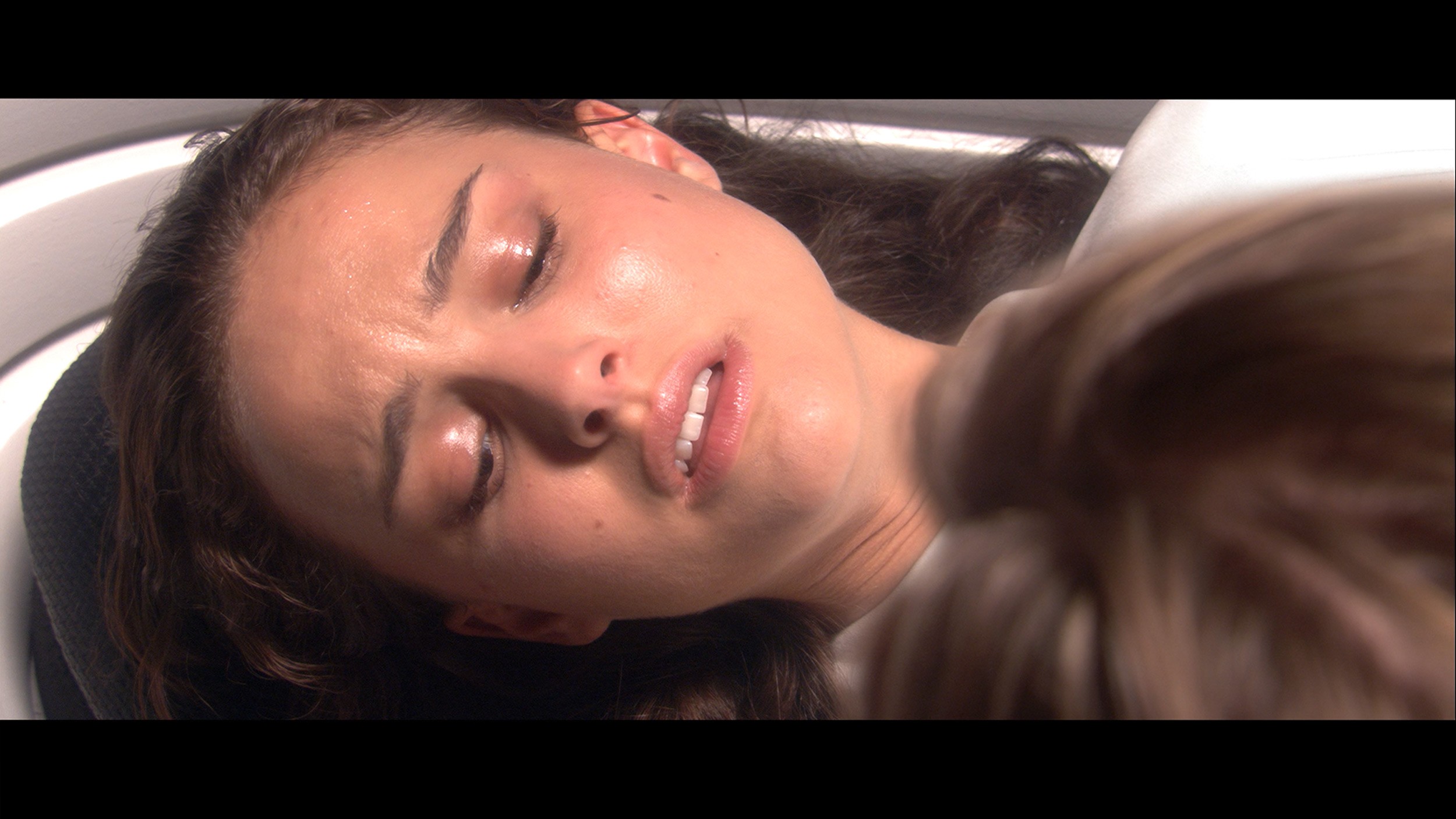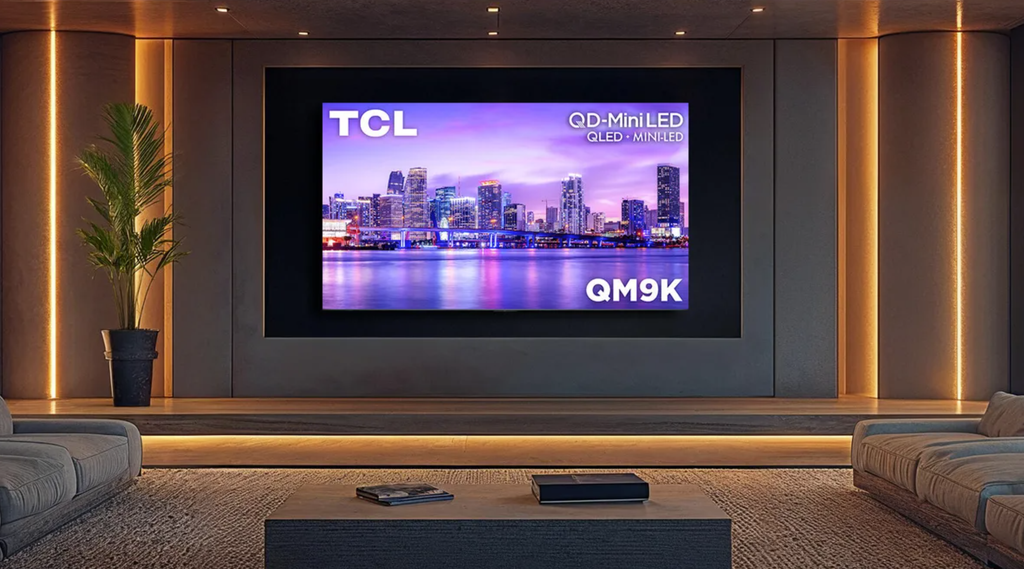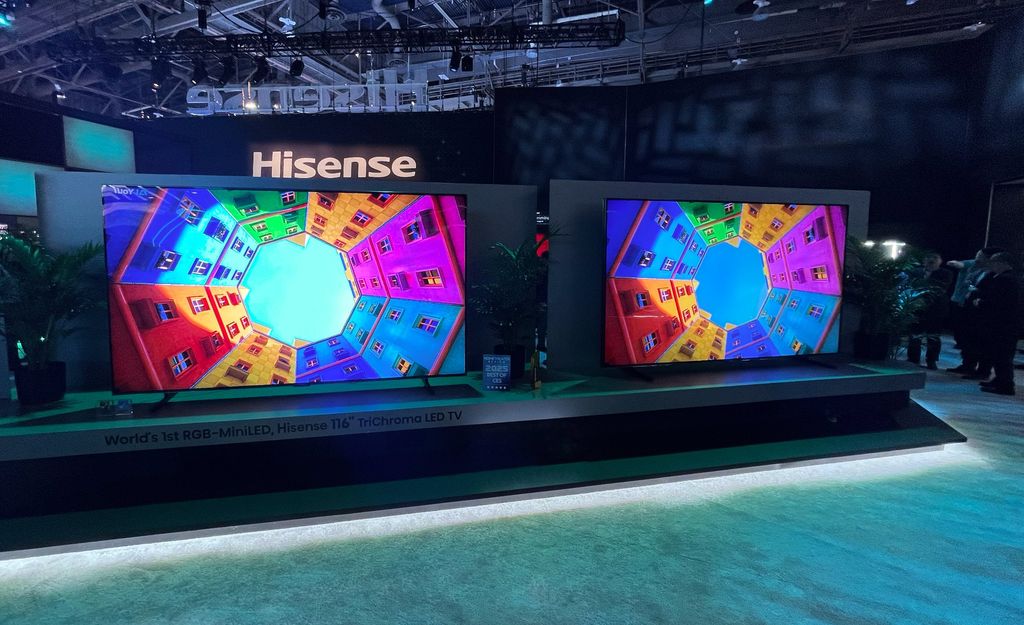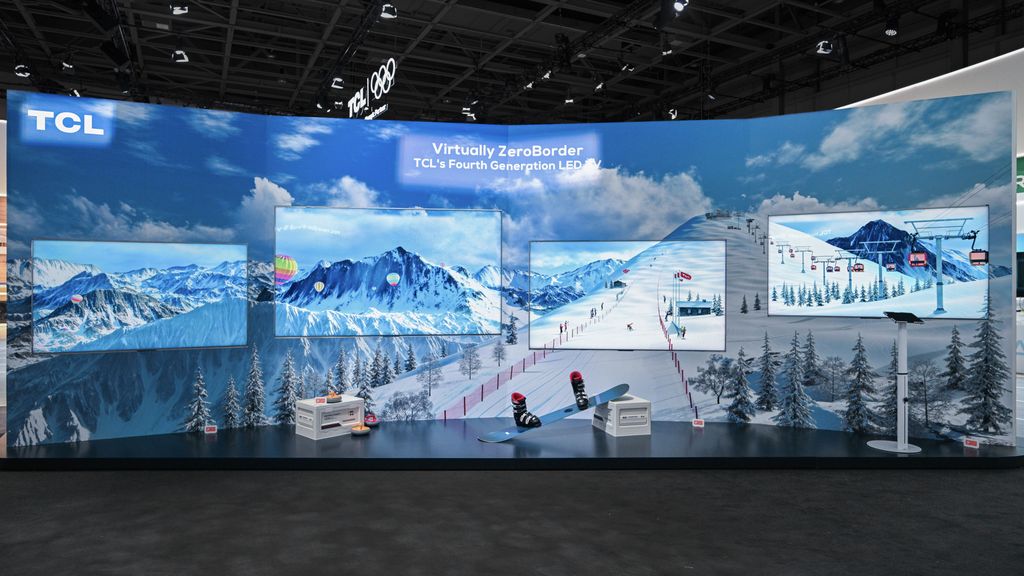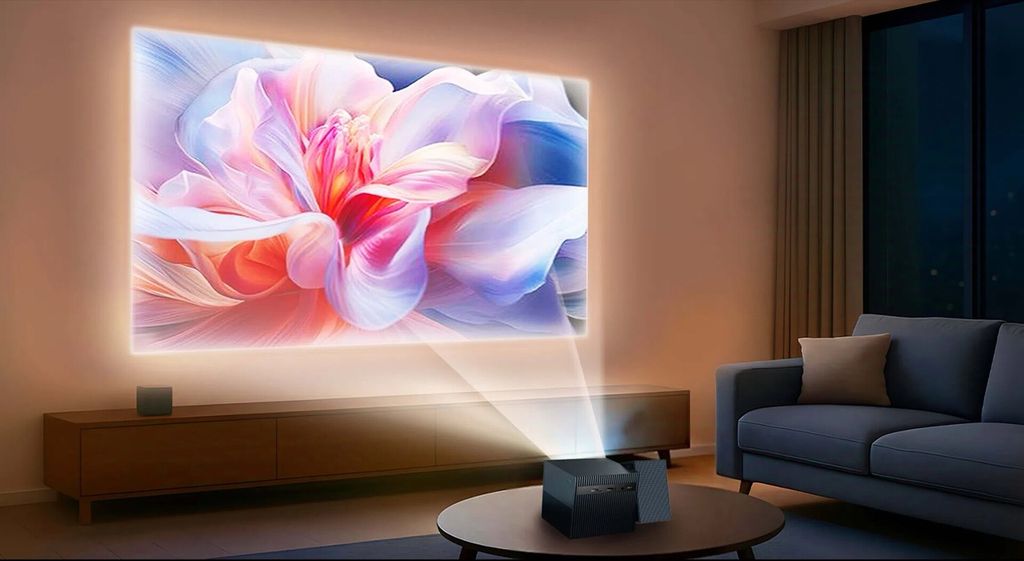- Matching (Score)
- Our verdict
- Competing TVs
- TV appearance
- Where to buy
- Contrast and black detail
- HDR effect quality
- Factory color reproduction
- Color reproduction after calibration
- Smoothness of tonal transitions
- Image scaling and smoothness of tonal transitions
- Blur and motion smoothness
- Console compatibility and gaming features
- Input lag
- Compatibility with PC
- Viewing angles
- Daytime performance
- TV features
- Apps
- Playing files from USB
- Sound
- Panel details
TCL C7K / QM7K 55"-85" Review
C7K / Q7C / MQLED85K / C79K / C71K / QM7K
Available screen sizes:
Diagonal with a different matrix:

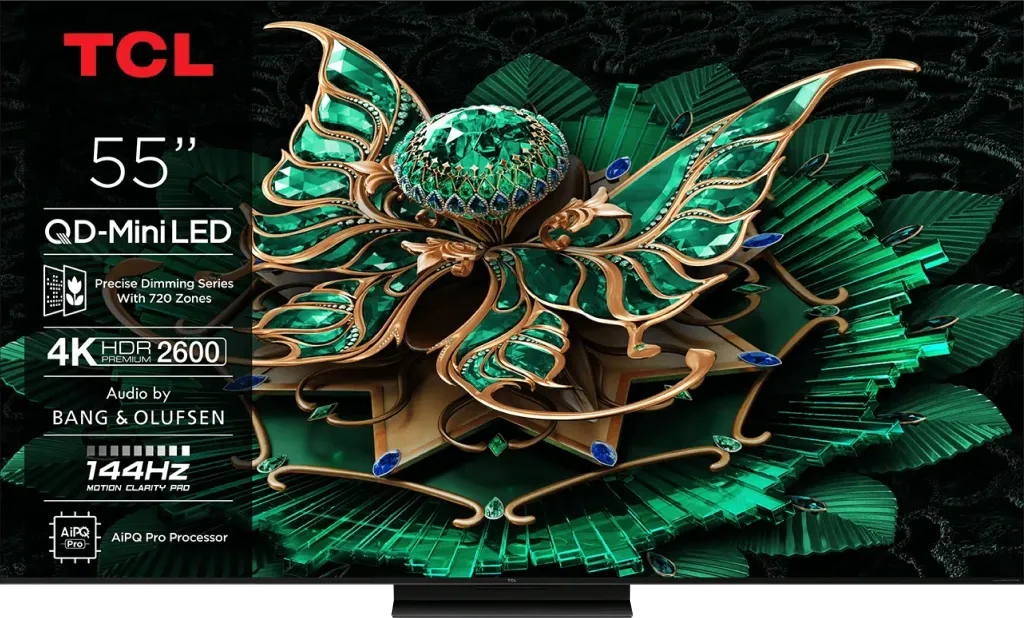
Complete the survey to find out the result
Panel type: LCD VA Refresh rate: 144Hz Brand: TCL Resolution: 3840x2160 System: Google TV Model year: 2025
The TCL C7K is a new, mid-range QD-MiniLED television for 2025, which is likely set to replace the very popular MQLED85 (C765) model from last year in the manufacturer's lineup. Right from the start, it stands out not only for its MiniLED backlighting technology and QD (quantum dots) screen but also for the newly established collaboration between TCL and Bang & Olufsen, which aims to provide better sound experiences. Sounds good? We've checked how the C7K performs in everyday use – from movies and games to system functionality. The test concerns the most popular variants, namely 55"-85".
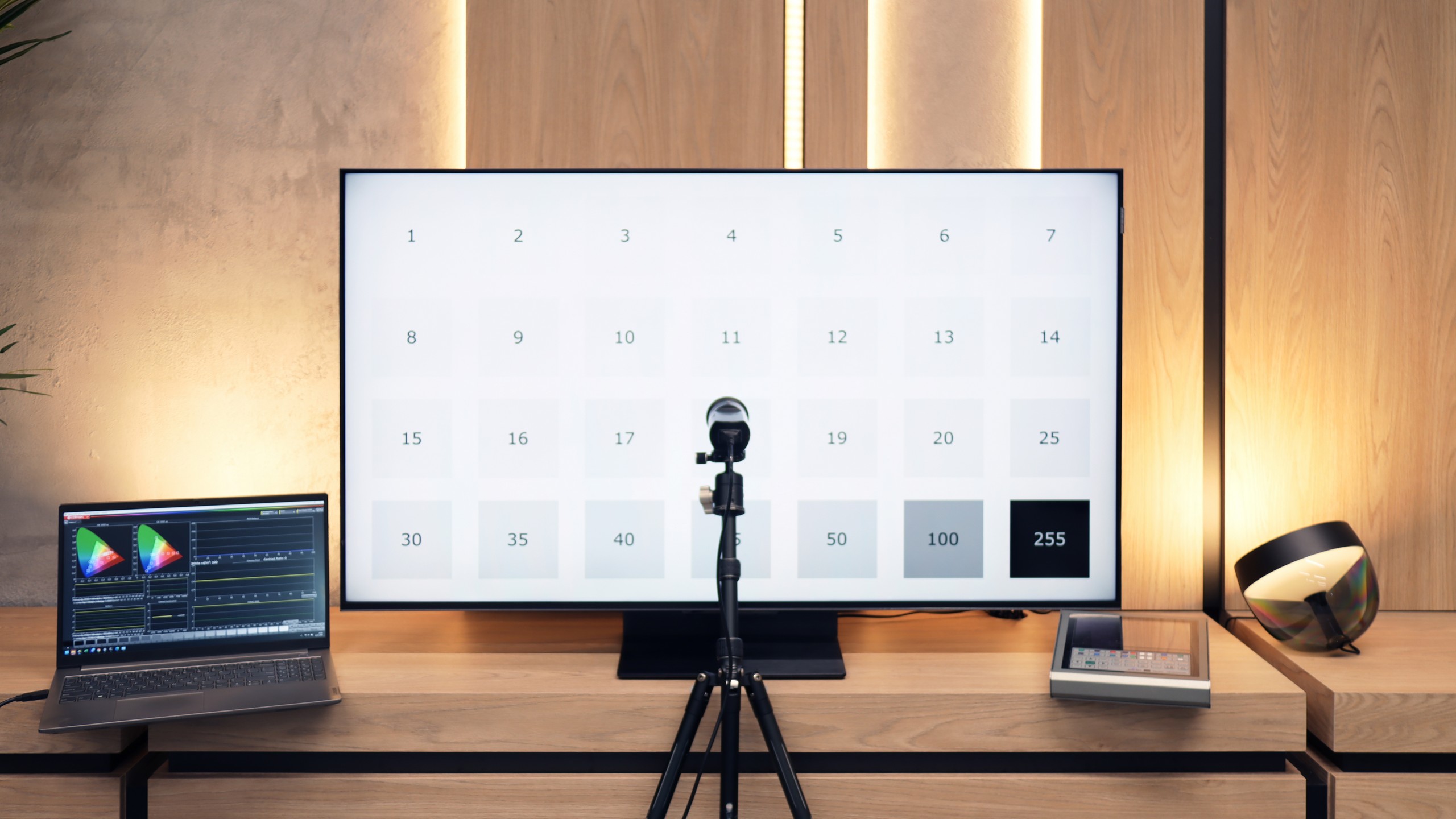
TCL C7K - Our verdict
7.4
Overall rating
There are TVs that go through testing and at first glance seem to be just another "medium-range" option. The TCL C7K looks just like that - without grand claims of revolution, without ambitions to dethrone OLEDs. Yet, after spending a few days with this model, it's hard not to conclude that it's truly a successful piece of equipment. The biggest advantages? Very good picture quality at a reasonable price. MiniLED combined with a QLED filter provides vibrant colours, high brightness, and contrast that really impresses in this class. Motion in sports or games looks smooth, and the presence of HDMI 2.1 and 144 Hz refresh rate makes gaming on this model a pure pleasure. On top of that, there's the Google TV system – it offers a huge range of possibilities: from voice control, through AirPlay support, to access to all the most important apps.
Are there any drawbacks? Yes. MiniLED still has its limitations, and in the most challenging movie scenes, one can notice compromises in dimming. Google TV also doesn't always function perfectly smoothly. But these are rather minor issues that don't overshadow the overall picture – and that is really positive. It's also worth noting the difference between variants. The 50-inch version we tested can be surprising, but the 55–85 inch models perform noticeably better – they have more local dimming zones, even higher contrast quality, and better sound quality. Therefore, if you're considering purchasing the C7K, it's definitely worth reaching for the larger size.
Advantages
Very good black - VA panel with a large number of Mini-LED zones
High brightness in HDR - over 1000 nits
Great for gamers - HDMI 2.1, low input lag, VRR, ALLM, etc.
Good motion smoothness - 144Hz panel
Supports multiple HDR formats: HDR10, HDR10+, Dolby Vision
Google TV operating system with access to a huge app library
Pleasant sound from built-in speakers (6.2.2) Bang & Olufsen
Disadvantages
Google TV can operate with minor stutters
No USB recording and PiP function
Movies and series in UHD quality
7.2
Classic TV, YouTube
6.9
Sports broadcasts (TV and apps)
6.8
Gaming on console
8.7
TV as a computer monitor
8.4
Watching in bright light
6.4
Utility functions
7.3
Apps
9.6
Sound quality
7.7
Complete the survey to find out what fits your preferences
TCL C7K - Competing TVs in this price range
TCL C7K - TV appearance
HDMI inputs: 2 x HDMI 2.0, 2 x HDMI 2.1 (48Gbps) Outputs: Toslink (Optical audio), eARC (HDMI), ARC (HDMI) Network Interfaces: Wi-Fi 2.4GHz, Wi-Fi 5GHz, Ethernet (LAN) 100Mbps
Build quality: Good
Stand type: Central
Bezel color: Graphite

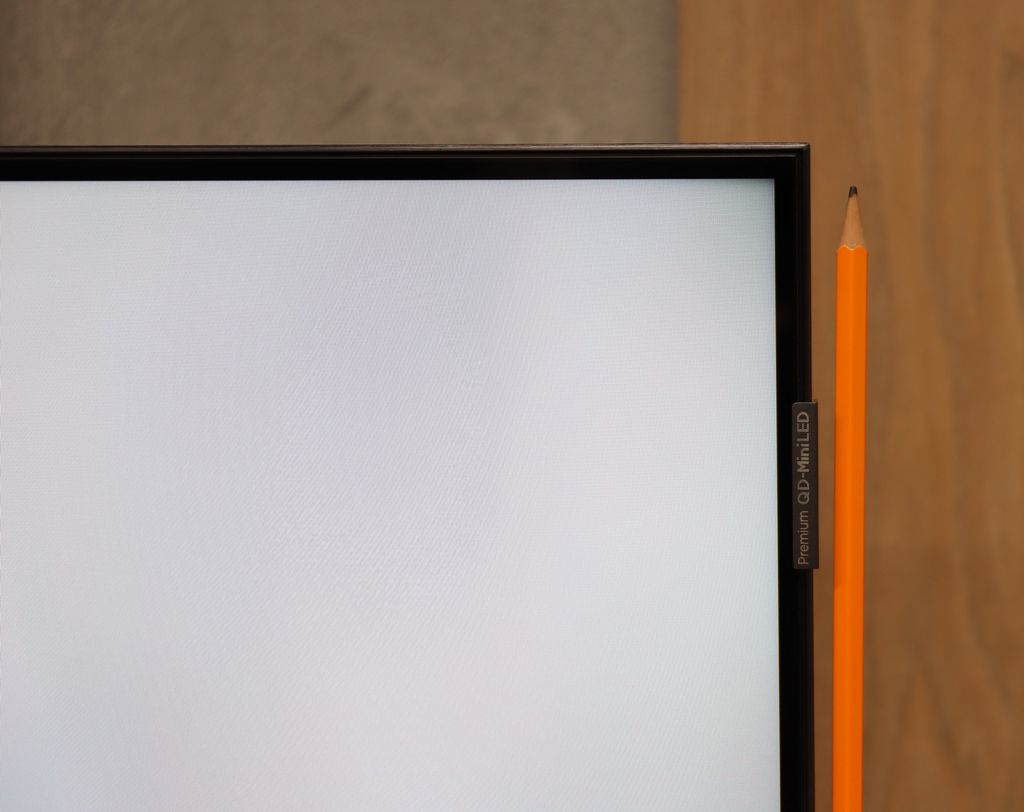
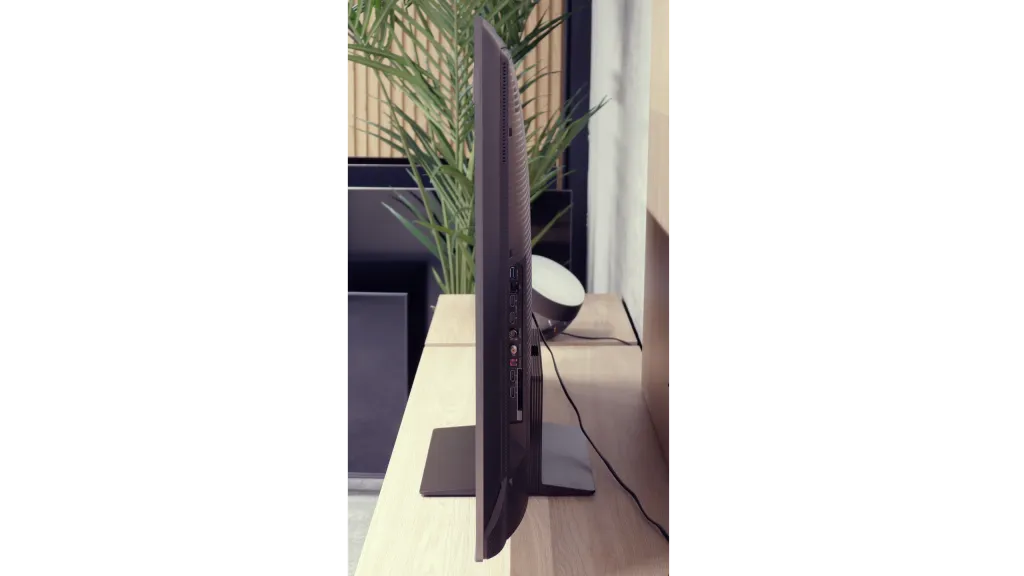
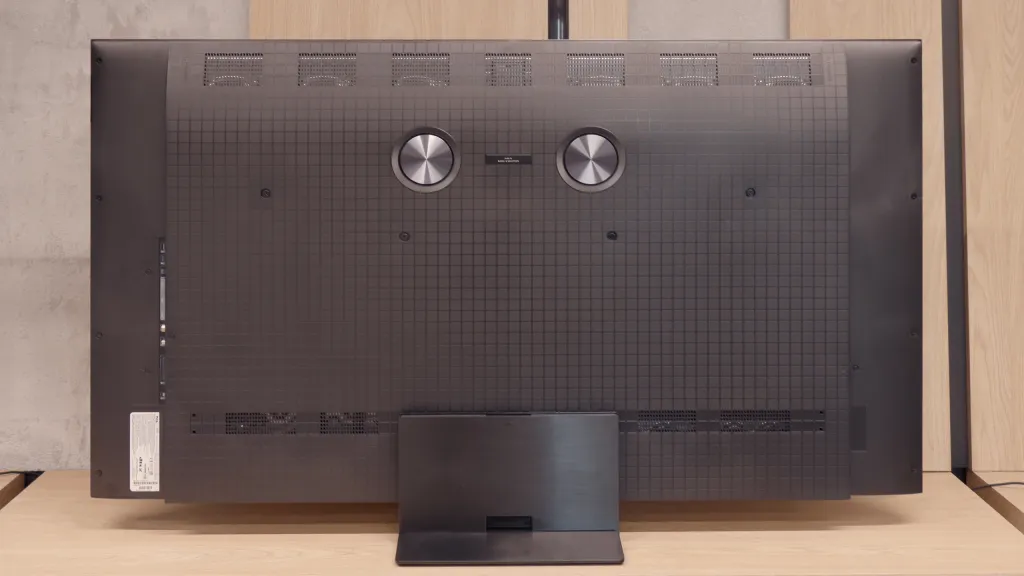
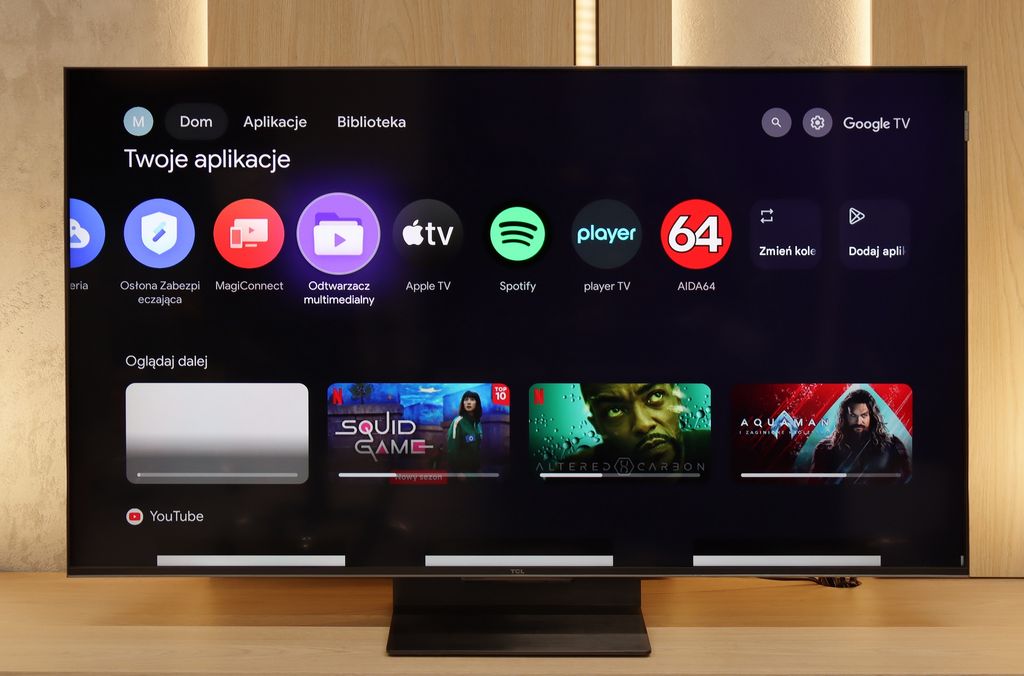
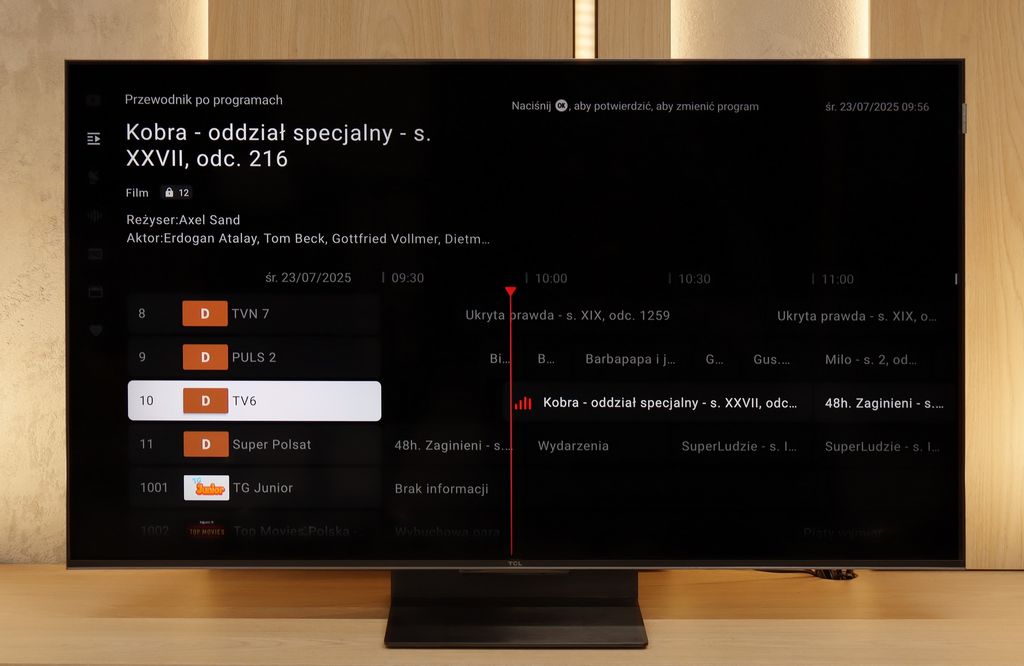

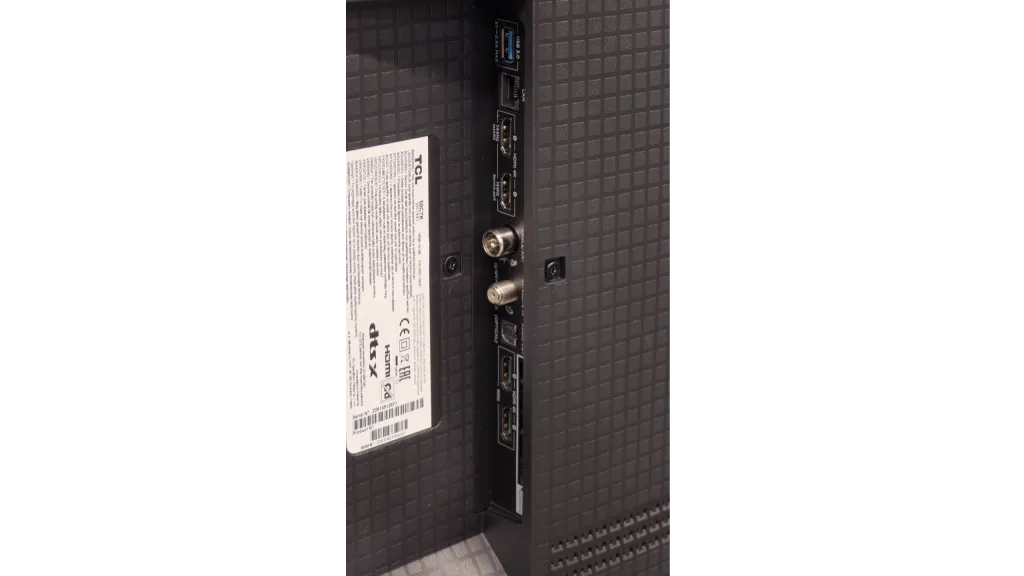

Stand: Fixed
Flat design: No
Accessories: Stand
TCL C7K is a television that makes a very good impression at first glance. The front of the device looks modern and elegant – thin bezels, a central stand, and a subtle metallic accent in the form of a narrow overlay with the inscription "Premium QD-MiniLED". It's a small detail, but it helps create the impression that we're dealing with high-end equipment. And indeed – looking from the front, it's hard to disagree with this. The C7K looks neat, modern, and solid.
In the larger variants from 55 inches, the manufacturer also ensured additional sound experiences – on the back of the casing, we find transducers branded with Bang & Olufsen. The whole thing is well-fitted, the materials don't creak, and the overall quality of workmanship in this price segment can be surprisingly impressive.
Buy at the best price
Select size:
TCL C7K - Contrast and black detail
8.1/10
Local dimming function: Yes, number of zones: 1008 (42 x 24)

Result
256,000:1

Result
59,850:1

Result
22,200:1

Result
16,850:1

Result
11,400:1
Visibility of details in the lights:
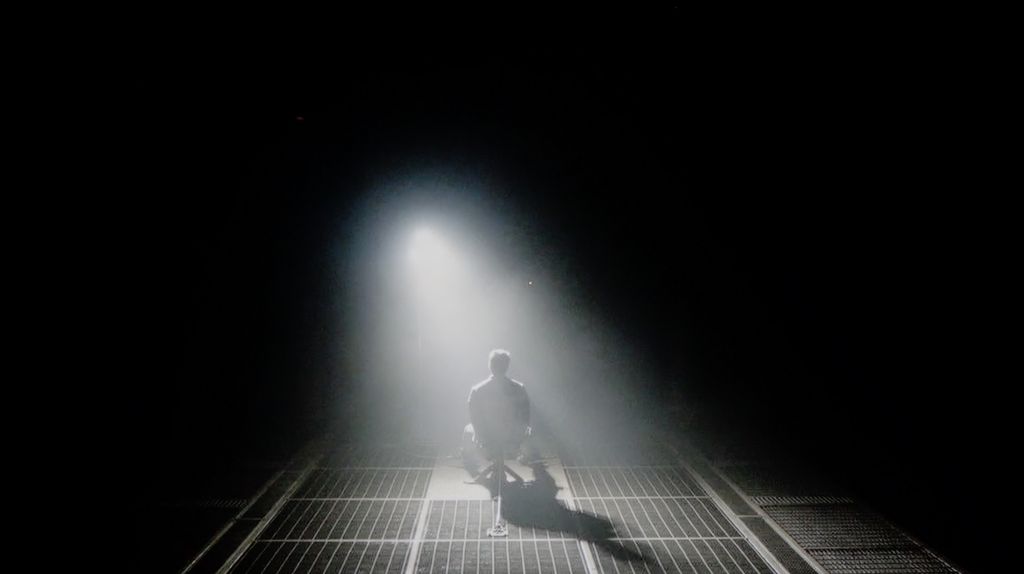
The results of the black and contrast tests in models from 55 to 85 inches are very similar, which is why in the main part of the evaluation we refer to the 65-inch version. It’s a natural phenomenon that larger sizes mean a greater number of backlight zones, and in the case of 65 inches, we counted over 1000 of them. The effect is very good – the contrast is at a high level and performs significantly better than in the smallest, 50-inch variant. Typical MiniLED limitations are still noticeable, such as the halo effect or somewhat too aggressive dimming of the image; however, here they are less perceptible than in the smaller model.
For comparison, it’s worth recalling that the 50-inch TCL C7K, despite being surprising with the use of as many as 336 dimming zones, struggled with managing the backlight in more complicated scenes – overexposures or loss of details occurred. In larger sizes, this problem doesn't disappear completely, but thanks to the greater number of zones, its impact on the perception of the image is less bothersome.
Halo effect and black detail visibility:
TCL C7K - HDR effect quality
6.2/10
Supported formats: HDR10, HDR10+, Dolby Vision, Dolby Vision IQ, HLG Color gamut coverage: DCI P3: 94.0%, Bt.2020: 73.5%
Luminance measurements in HDR:

Result
1108 nit

Result
405 nit

Result
865 nit

Result
290 nit

Result
848 nit
In terms of brightness, the models ranging from 55 to 85 inches in the C7K series are truly impressive. Under optimal testing conditions, the 65-inch screen exceeded 1200 nits, which in practice means that the brightest scenes can dazzle with almost cinematic brilliance. These are not just dry figures from measurements – during screenings, bright skies, explosions, or reflections of light on water looked incredibly striking, often giving the impression that the television exceeds its price range. This is particularly effective in scenes with large areas of illumination, where the screen fills with intense brightness – for instance, in sun-drenched shots or during dynamic action sequences. Viewers looking for strong HDR will definitely be satisfied.
However, scenes that require precise backlight control – with tiny points of light against a dark background – prove to be more challenging. Here, the C7K, despite having over a thousand zones, can still dim brightness to maintain deep blacks. The effect is that in films like Sicario 2 or LIFE of Pi, some details, such as a distant lighthouse or single reflections, may appear less distinct or blend into the surroundings. This is a compromise inherent in MiniLED technology – it provides excellent image depth and blacks at a level not offered by standard LCDs, but this comes at the cost of limited visibility of the tiniest lights.
Scene from the movie “Pan” (about 2800 nits)

Scene from the movie “Billy Lynn” (about 1100 nits)

In bright film scenes, the TCL C7K can truly surprise in a positive way. In test sequences from films like Pan or Billy Lynn – where the screen has to face fireworks, explosions, or sharp sunlight – the TV performed really well. The light effects looked dynamic and intense, and although they obviously don't reach the level of reference screens capable of displaying 4000 nits, the experience was very satisfying. The colour accuracy occasionally deviated slightly from perfection – we noticed a subtle cooling of colours in some scenes – but overall, the image presented itself pleasantly despite a slight exaggeration. This is a result that will undoubtedly satisfy most viewers, even those with slightly higher expectations. The darker portions of the image perform a bit weaker, especially where characters or elements of the set appear in the background. In such moments, it’s clear that TCL heavily prioritises deep blacks at the expense of details – and the screen can significantly dim those areas of the image. Was this the intent of TCL's engineers? It's hard to say, but generally, the visual effect will appeal to most users – as the blacks really can make an impression here.
HDR luminance chart:
HDR luminance
TCL has taken a very pragmatic approach to HDR formats for years – instead of opting for just one option, it offers a complete set of possibilities. In the C7K model, we get everything that matters today – HDR10, HDR10+ and Dolby Vision. And that’s really good news, because whether we’re watching something from Netflix, Prime Video, or a 4K disc, we can be sure that the television will display it in the best way possible. The differences can truly be seen with the naked eye. In the comparison photo we prepared, you can clearly see how Dolby Vision can bring out more detail – both in the bright and dark areas of the image – compared to standard HDR10. This is thanks to dynamic metadata, which adjusts contrast and brightness for each scene, rather than sticking to one rigid setting for the entire movie. As a result, the image has more depth, and the HDR effects really “do the job”. It's great that TCL doesn’t limit the user and simply provides full support for all popular standards.
Static HDR10

Dynamic: Dolby Vision

Factory color reproduction
6/10
The new feature in TCL TVs for 2025 is the long-awaited Filmmaker mode, which until now has been found in most competing brands. This is great news, as this mode is regarded as the one that best represents the original vision of the creators and is often recommended by enthusiasts of good picture quality. Unfortunately – as is often the case – the mere presence of it does not guarantee perfection. The Filmmaker mode in the TCL C7K is not without its flaws. One could critique the incorrect white balance, particularly the slight dominance of blue, which caused cool, slightly greyish skin tones. But that was not the biggest issue. The main complaint was the excessive brightness exposure, which is clearly visible on the gamma and EOTF graphs. The picture was simply too bright, at times even blown out, which affected not only the richness of the scenes but also the overall viewing experience. Some details were simply lost, and the whole image looked as if someone had overdone the brightness slider a bit. As always – we decided to see what could be squeezed out of this after calibration. And that’s where it started to get really interesting…
Color reproduction after calibration
7.5/10
After calibration, the TCL C7K put on a really good show, especially when it comes to SDR content. We managed to precisely tune the white balance, colour gamut, and brightness characteristics, resulting in colour errors on the ColorChecker palette dropping below a value of 2. For the uninitiated – this is an almost perfect score, meaning the image is very close to what the creators intended. Unfortunately, things didn’t look as good with 4K HDR content. While we managed to slightly calm down the white balance and correct its previous errors, it still shows that the TV has some "MiniLED traits," especially in brightness management. When we checked how the C7K handles the EOTF curve on actual movie scenes, rather than just synthetic test patterns, it turned out that the screen still has a tendency to slightly brighten the entire image. This affects the overall experience – blacks lose some depth, and the image becomes less contrasty than it should be. Despite these minor shortcomings in HDR content, the overall reception of materials – especially in SDR – is really very good. After calibration, the C7K can display an image that can successfully compete with much more expensive models. Good tuning of colours, natural skin tones, and pleasant brightness make movie sessions and everyday content viewing more than satisfying.


TCL C7K - Smoothness of tonal transitions
8.6/10
The TCL C7K performs very well with colour gradation – in most tested scenes, tonal transitions were smooth, and colours blended together without visible edges or an artificial "splotch" effect. In everyday use, it's hard to find any faults – the image looks natural, without jarring transitions or digital artifacts. Some limitations only arise in very dark tones – particularly in a heavily muted grey palette, where the TV may struggle to reproduce an ideal gradation. But this is absolutely understandable, as even many significantly more expensive models in this range simply fail. Fortunately, these situations are rare and do not significantly affect the overall perception.


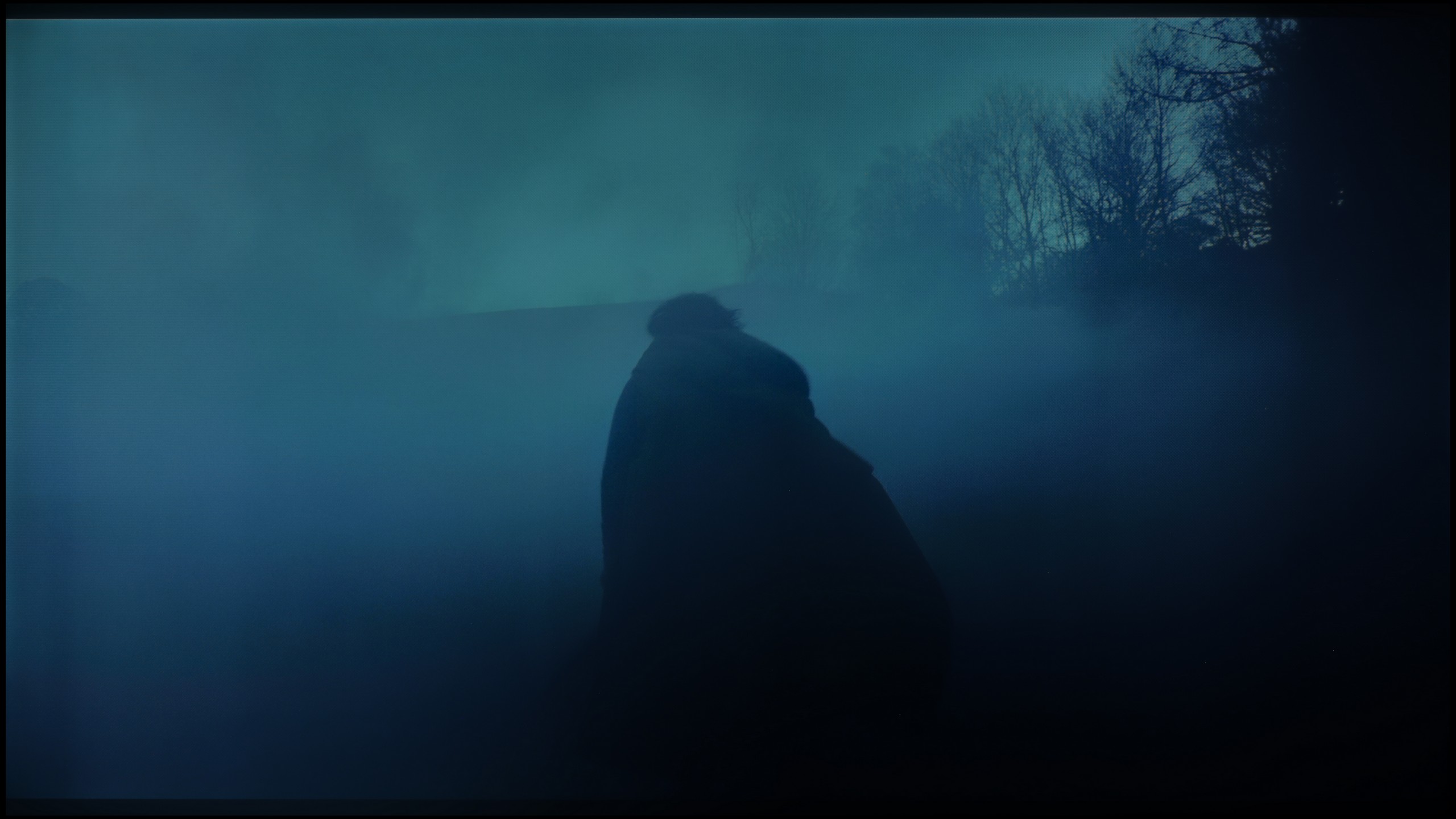





Image scaling and smoothness of tonal transitions
5.5/10
Smooth transition function
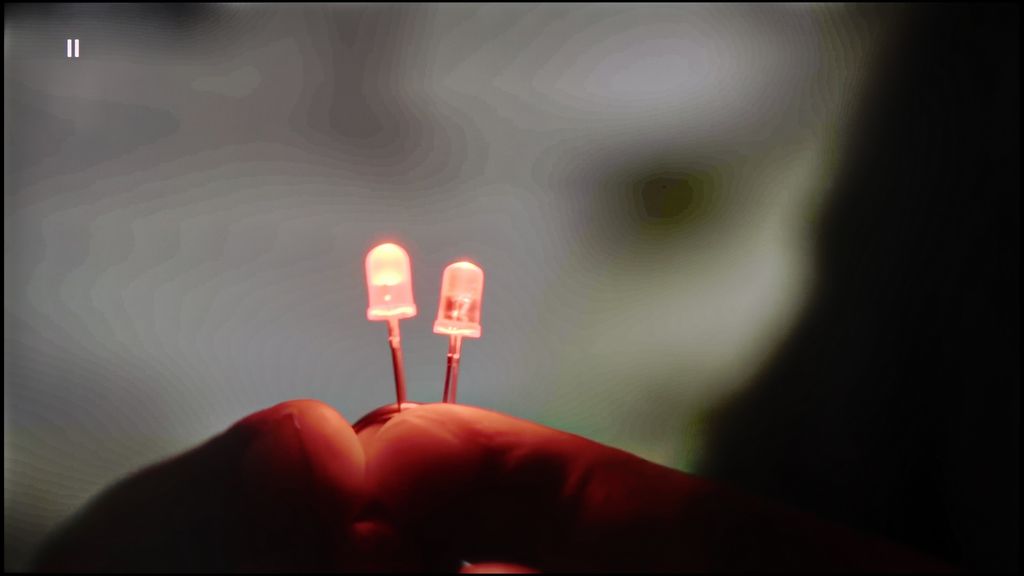
Image without overscan on the SD signal

TCL C7K comes with a feature that, according to the manufacturer, aims to smooth out unwanted colour transitions – something like a rescue for less successful tonal changes. It's called "Gradual Smoothing" and... well, it sounds ambitious, but in practice, it works very poorly. Regardless of whether we set it to low or high, the difference is minimal. And worse still – the feature can cut out elements from the image that should remain. Fortunately, film grain is left untouched, so at least it doesn't smooth everything indiscriminately, but even so – it's best to just turn this option off.
When it comes to upscaling lower resolution content, it's already better. SD and HD materials look quite decent, although at times we felt that the image loses sharpness and becomes too soft – as if something had taken away its clarity. Fortunately, with very low sources (e.g. 576p), there was no overscan effect, meaning the image wasn't artificially cropped – everything fit on the screen as it should.
TCL C7K - Blur and motion smoothness
8.1/10
Maximum refresh rate of the panel: 144Hz
Film motion smoothing option: Yes
Blur reduction option: Yes
BFI function 60Hz: Yes, 120Hz (double contours)
BFI function 120Hz: Yes, 120Hz
Brightness drop with BFI: 31%
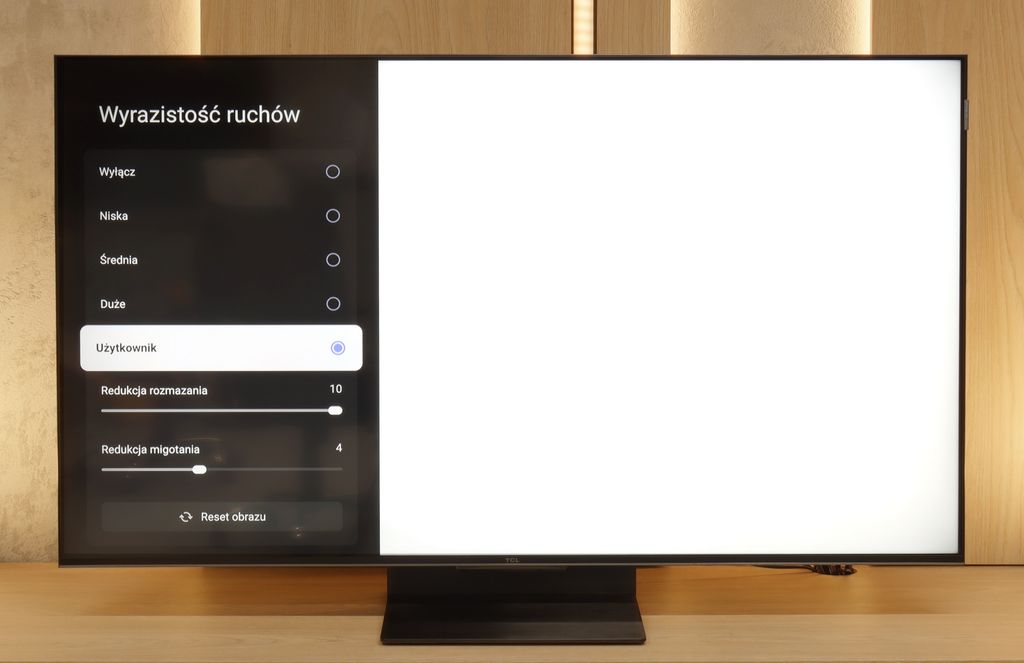
TCL C7K handles motion smoothness really well. The panel used in it offers a refresh rate of 144 Hz, which alone suggests that this TV is more than just a regular "60 Hz" panel. Moreover, if we connect the C7K to a computer and set the resolution to Full HD. But we will write more about this in the section for gamers and PC compatibility. Returning to everyday use – both sports and movies look very good here. Thanks to the quick panel and the well-functioning motion smoothening feature, the C7K is great for watching matches as well as for movie screenings. In the menu, we find two sliders – blur reduction and flicker reduction – that allow adjusting the smoothness effect to personal preferences. At lower settings, we get a more cinematic effect, with a slight judder. At higher settings – the image becomes more theatrical, smoothly even to excess. Whatever your taste, everyone can set it to their liking.
Blur (native resolution, maximum refresh rate):


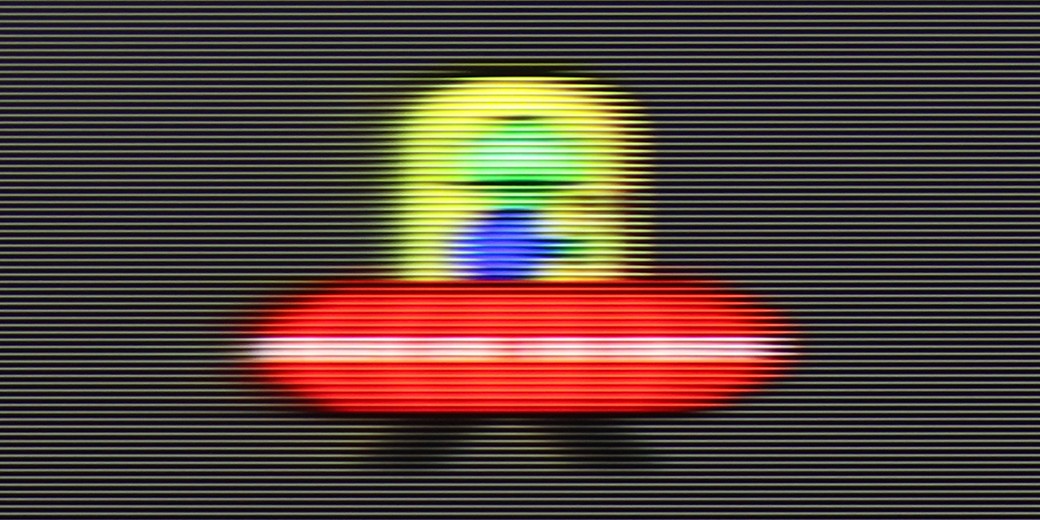
Blur (BFI function enabled):



Blur (4K@144Hz):



We have to say it straight – we’re a bit shocked at how well the C7K handled motion blur. Or rather... its absence. For an LCD, this panel responds exceptionally quickly, which is a real rarity today, even in pricier models. Of course, the more pedantic will notice that in very dark scenes, you can still spot slight traces of motion blur – but that's more of an exception than the rule. For those particularly sensitive to smoothness, TCL has prepared something extra – the BFI feature, which inserts a black frame between images. Does it work? Yes. It clearly reduces motion blur, but unfortunately, it can cause "smearing" of contours in dynamic scenes. Brightness doesn't drop as dramatically as it does with many competitors – where turning on BFI can dim the screen by half or more. Here, the drop is barely noticeable. Is it worth using? We wouldn't really recommend it – the panel performs very well without this option anyway. But if someone wants to – by all means, there’s plenty to choose from.
TCL C7K - Console compatibility and gaming features
9.8/10
ALLM: Yes
VRR: Yes
VRR range: 48 - 240Hz
Dolby Vision Game Mode: Yes
Correct implementation of HGIG: Yes
1080p@120Hz: Yes
1440p@120Hz: Yes
4K@120Hz: Yes
Game bar: Yes
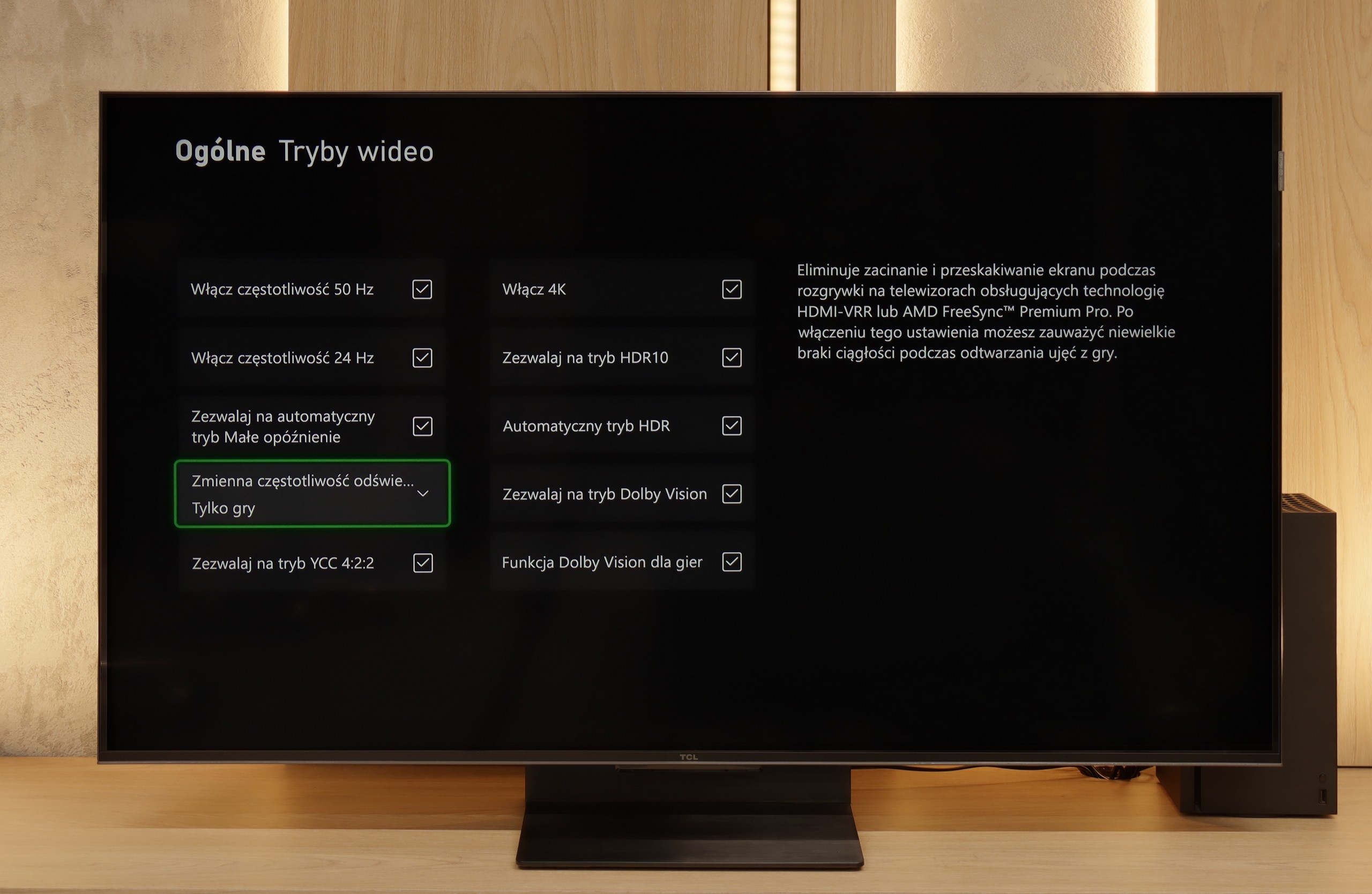
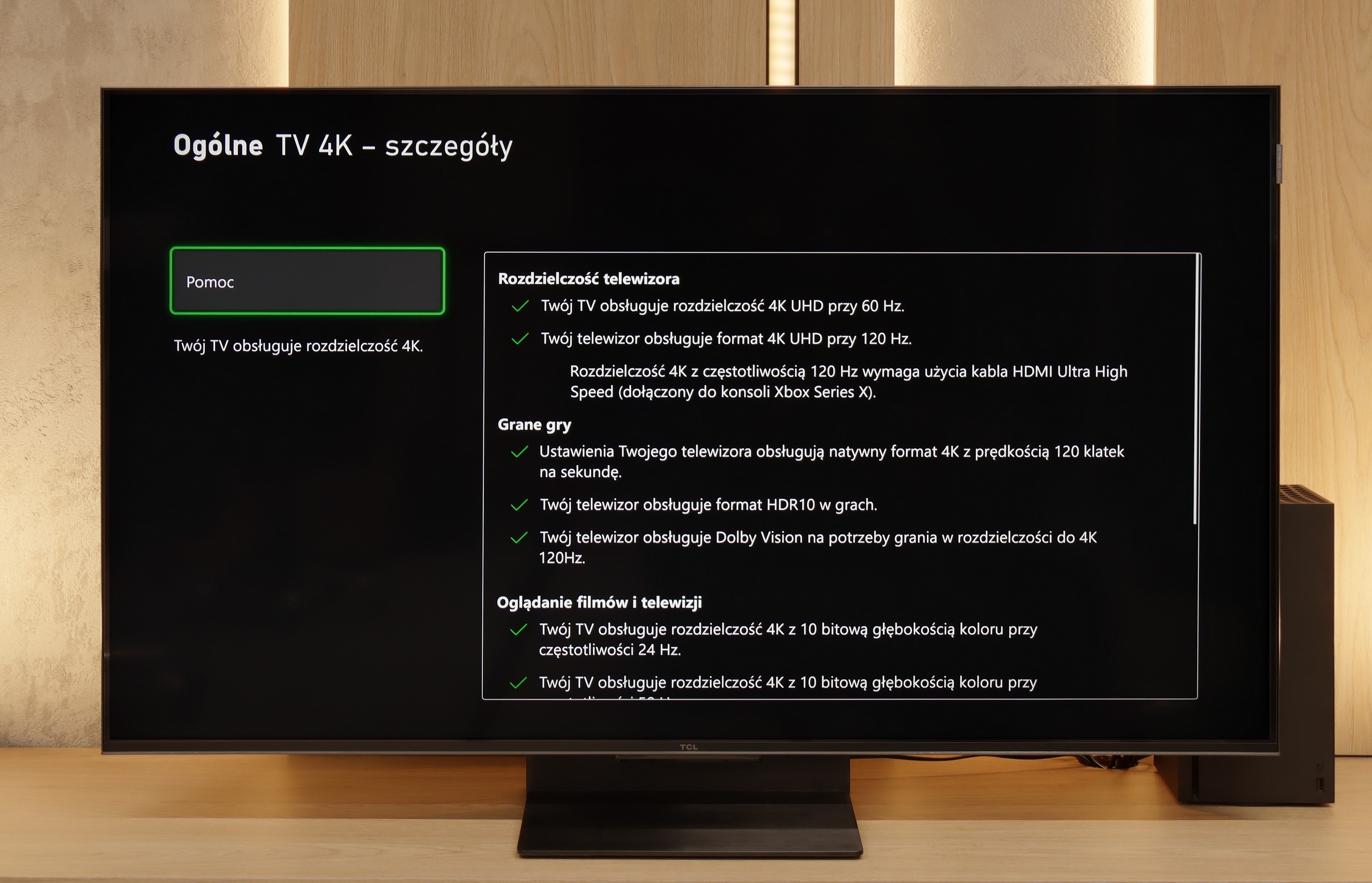
TCL C7K is a TV that on paper looks like the dream gear for a gamer – and most importantly, it also holds up in practice. First, the good news: we have two HDMI 2.1 ports with full bandwidth, so we can easily connect both a console and a computer, making use of all their capabilities. The panel itself supports a refresh rate of 144 Hz, which gives a considerable advantage in fast-paced games. On top of that, it comes with a full suite of gaming features: VRR (variable refresh rate), ALLM (automatic low latency mode), and Dolby Vision support in games. There’s also an HGiG mode that provides an HDR effect aligned with the creators' intentions. GameBar, which is an information bar for gamers. It operates quickly, looks clear (like a Nintendo console👌), and displays what matters most: the current frame rate, VRR status, and even HDR parameters.
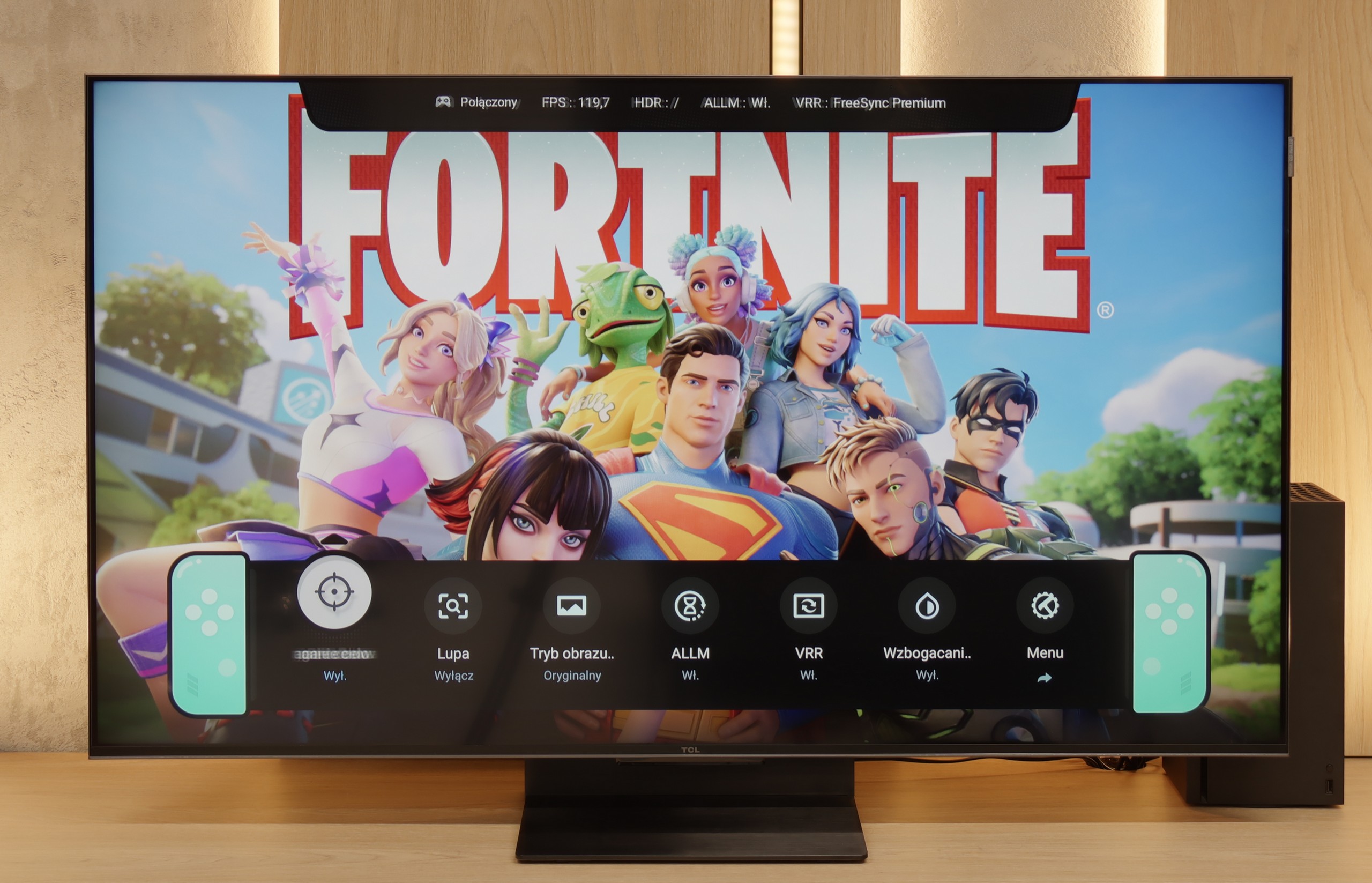
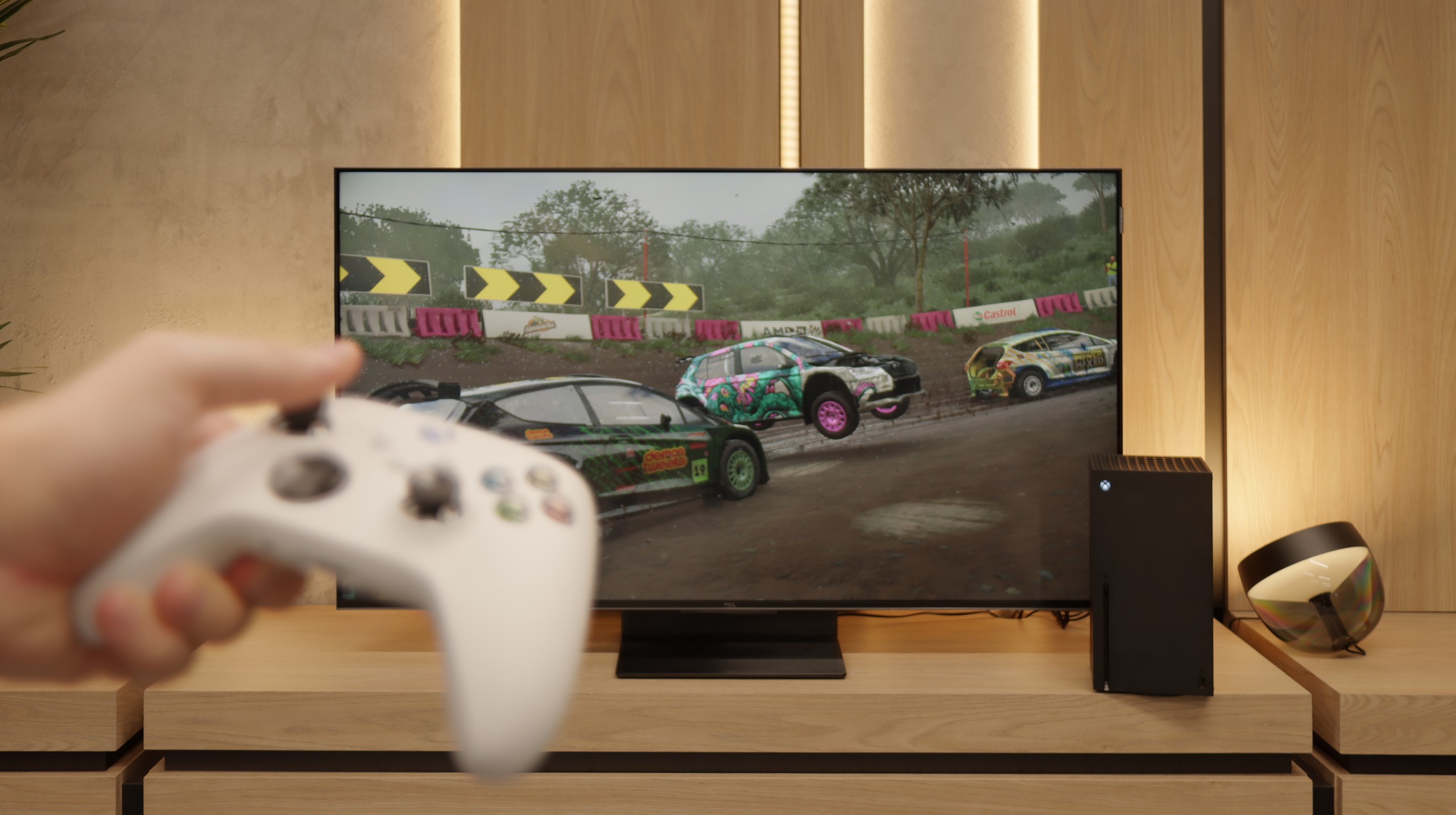

TCL C7K - Input lag
9.6/10
When it comes to delays, the C7K doesn’t give any reasons to complain. In games at 120 Hz, the input lag is around 10 ms, which means the TV responds really quickly. And interestingly – even in Dolby Vision mode, the result is very similar, which isn’t always the standard. Good job, TCL. At 60 Hz, the lag does increase a bit, but that’s completely normal and applies to pretty much every TV with 120Hz refresh rates and higher. The important thing is that everything still runs smoothly and there’s no feeling that anything is unresponsive to our actions.
| SDR | HDR | Dolby Vision |
|---|---|---|
| 1080p60: 18 ms | 2160p60: 18 ms | 2160p60 DV: 18 ms |
| 1080p120: 12 ms | 2160p120: 12 ms | 2160p120 DV: 12 ms |
| 2160p60: 18 ms | ||
| 2160p120: 12 ms |

TCL C7K - Compatibility with PC
8.4/10
Chroma 444 (maximum resolution and refresh rate): Yes
Font clarity: Good
Readability of dark text and shapes: Good
Input lag in PC mode (4K, maximum refresh rate): 12ms
Matrix subpixel arrangement: BGR
Max refresh rate: 144Hz
G-Sync: Yes
If we intend to connect the C7K to a computer – especially for gaming – there's definitely something to play with. We've got 4K at 144 Hz, which already sounds fantastic, but if we lower the resolution, the TV can display even 280 Hz. In e-sports, where every fraction of a second counts, this really makes a difference. On top of that, there's support for G-Sync and FreeSync, so no matter what graphics card we have – the image will be smooth, with no stuttering or tearing.
But if we plan to set the C7K on a desk and use it like a monitor, it's a bit less "rosy." Sure, it supports chroma 4:4:4, so fonts should be sharp, but with very dark letters, there's a slight blurriness and dimming of the edges. It's not something that immediately stands out when gaming or watching, but when working with text – it might be distracting. In everyday use – probably without worries, but if we plan to place a 50-inch screen a metre from our face, it's worth keeping this in mind.
TCL C7K - Viewing angles
3/10
Brightness drop at an angle of 45 degrees: 78%
There are no surprises here – the C7K has classic viewing angles for a VA panel. That is: we sit directly in front – it's fantastic. Colours look good, contrast is strong, everything is in place. But just shifting slightly to the side makes it worse – the image loses saturation, blacks go grey, and the overall impression diminishes somewhat. So if we're planning to watch together with a few people or have a couch that takes up half the living room – it's worth seating everyone more centrally. You can watch from the side, but don’t expect miracles – it's simply a characteristic of the VA panel.
TCL C7K - Daytime performance
6.4/10
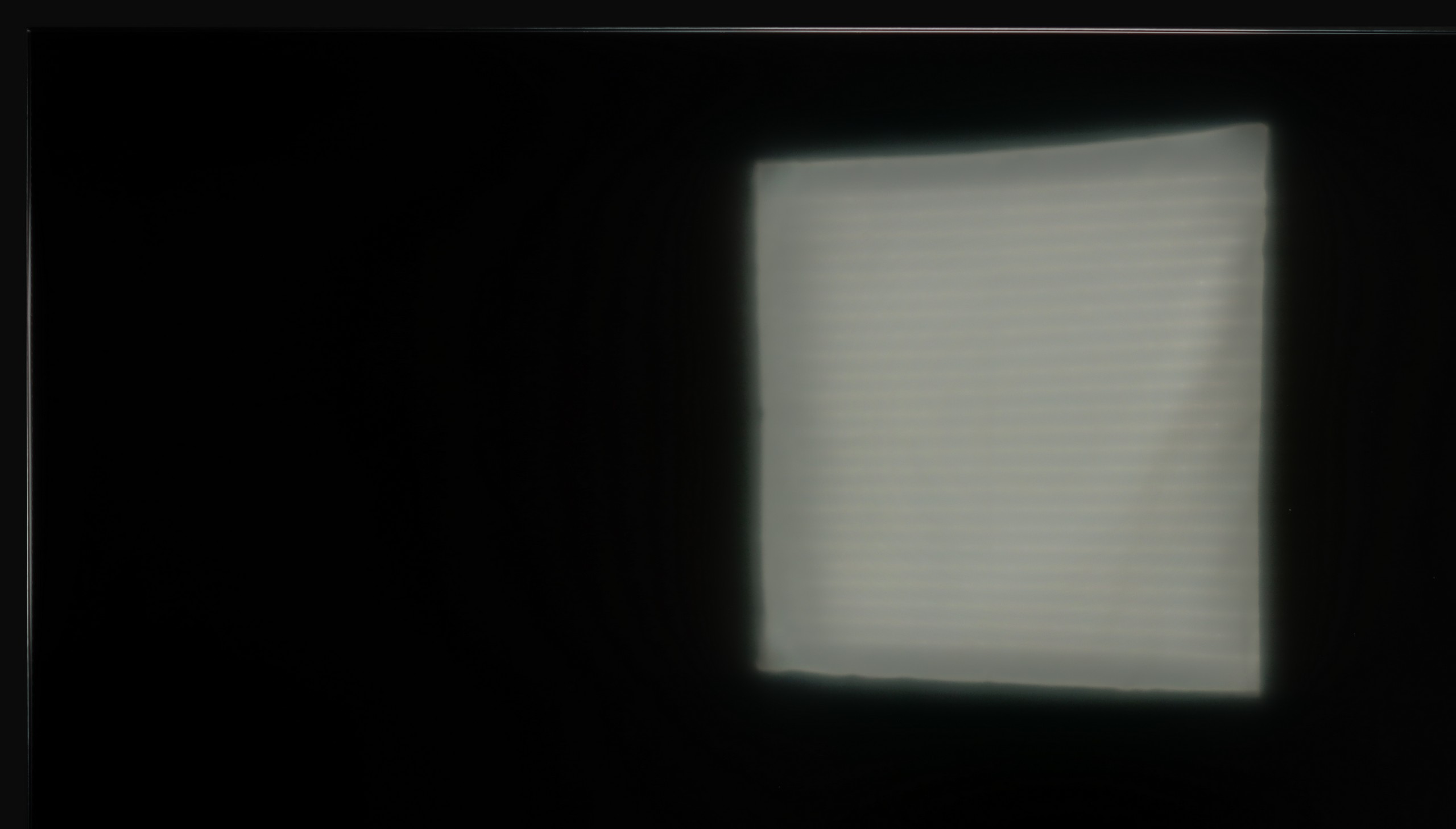

Panel finish: Satin
Reflection suppression: Good
Black levels during daytime: Very Good
Fortunately, the TCL C7K performs quite well in a bright room. The screen has a satin finish, which effectively reduces reflections and means that even on sunny days we don't have to worry about reflections from lamps or windows. Importantly, the colours maintain their intensity and don't wash out as can happen with weaker matte panels. As for brightness, the average for content like YouTube or regular television is a bit below 500 nits. It's not a record-setting result – for example, the MQLED85 (C765) performs better in this regard. However, for everyday viewing during the day, it should work without major issues, as long as we don't plan to place it opposite a south-facing window without curtains.
Panel brightness
Average luminance SDR
TCL C7K / QM7K 55"-85": 529 cd/m2
TCL C7K - TV features
7.3/10
System: Google TV
System performance: Good
- HDMI inputs: 2 x HDMI 2.0, 2 x HDMI 2.1 48Gbps
- Outputs: Toslink (Optical audio), eARC (HDMI), ARC (HDMI)
- Network Interfaces: Wi-Fi 2.4GHz, Wi-Fi 5GHz, Ethernet (LAN) 100Mbps
- TV reception: DVB-T, DVB-T2, DVB-S, DVB-S2, DVB-C
Classic features:
Recording to USB (terrestrial TV): No
Recording programming: No
Picture in Picture (PiP): No
RF remote control (no need to aim at the screen): RF
Backlit remote control: No
Teletext: Yes
Audio only mode: Yes
Bluetooth headphones support: Yes
Simultaneous Bluetooth headphones & TV audio: Yes
Smart features:
AirPlay: Yes
Screen mirroring (Windows Miracast): Yes
Voice search: Yes
Voice search in native language: Yes
Ability to connect a keyboard and mouse: Yes


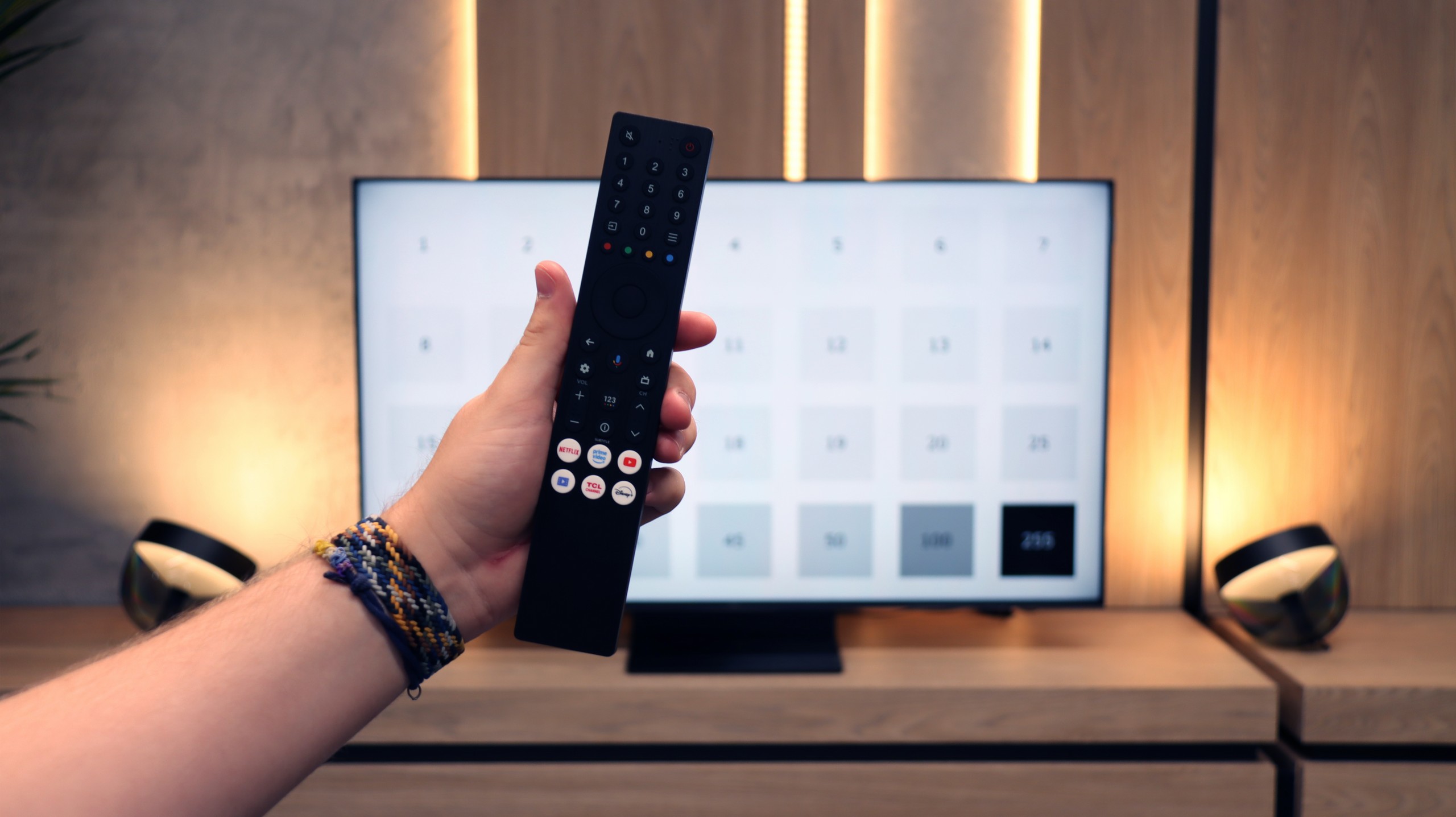





SmartTV: GoogleTV
The greatest strength of the TCL C7K in everyday use is undoubtedly the Google TV system. Thanks to it, we have access to an almost endless library of applications, including some more niche ones that are often unavailable on other platforms. The built-in Google Assistant understands Polish, so we can easily ask what’s on TV, what the weather is like, and even give a few voice commands to control the television. The presence of Chromecast and AirPlay, which work smoothly and make life easier, is also a plus.
Useful features
However, the classic features are a bit lacking. Of course, we find the basics here – teletext, EPG or the ability to connect headphones – but that’s pretty much it. There’s a lack of USB recording functions and a picture-in-picture (PiP) mode, which can sometimes still be found with competitors. It's also worth remembering that the Google TV version from TCL can sometimes have strangely translated menu items or minor interface bugs. These are not things that hinder everyday use, but those sensitive to details may notice them.
Sound connection options
HDMI audio:
Other audio outputs:
Toslink: Yes
Wireless audio:
Bluetooth: Yes
Atmos Flex Connect: Yes
Supported audio formats (external HDMI eARC audio):
Dolby Digital Plus 7.1: Yes
Dolby True HD 7.1: No
Dolby Atmos in Dolby Digital Plus (JOC): Yes
Dolby Atmos in Dolby True HD: No
DTS:X in DTS-HD MA: Yes
DTS-HD Master Audio: Yes
Senior accessibility
Numeric keyboard on TV: Yes
Font size adjustment: No
Audio description: Yes
TCL C7K - Apps
9.6/10























TCL C7K - Playing files from USB
9.2/10

| Maximum photo resolution: | Supported photo formats: |
|---|---|
The built-in file player in the TCL C7K performs really well. It supports most popular audio and video formats, so if we want to quickly throw something from a USB stick and play it – there shouldn't be a problem. Of course, as is often the case, there might be some minor shortcomings – not every exotic codec will work (Apple's HEIC), not all subtitles will be perfectly synchronised (txt.). However, this is where the biggest advantage of this TV comes in, namely Google TV. With access to the Google Play Store, we can easily install an alternative player, such as VLC, and then no files will be a concern for us.
TCL C7K - Sound
7.7/10
-
Maximum volume
Supported codecs
(TV speakers)
Dolby Digital Plus 7.1
Dolby True HD 7.1
Dolby Atmos in Dolby Digital Plus (JOC)
Dolby Atmos in Dolby True HD
DTS:X in DTS-HD MA
DTS-HD Master Audio
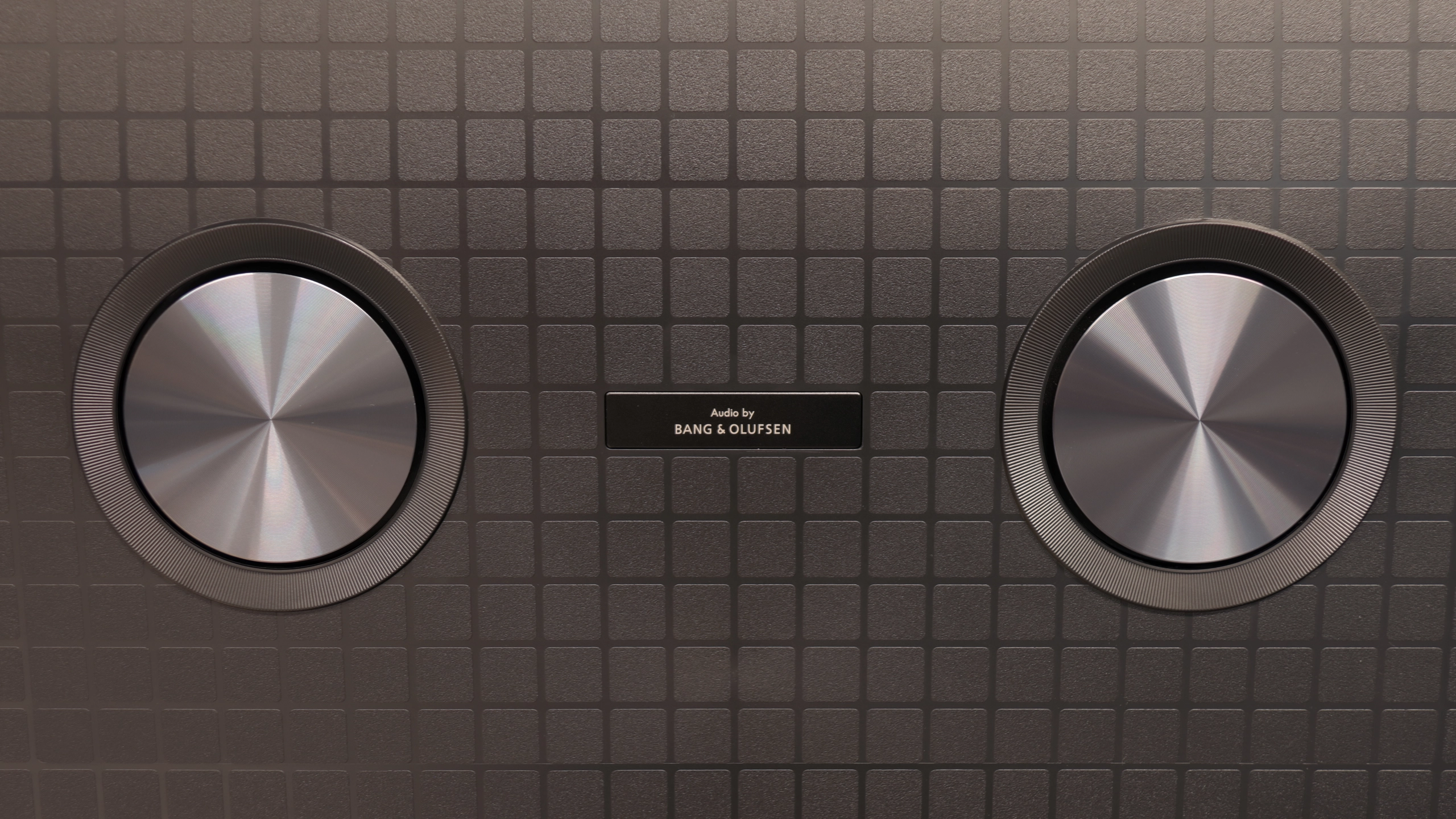
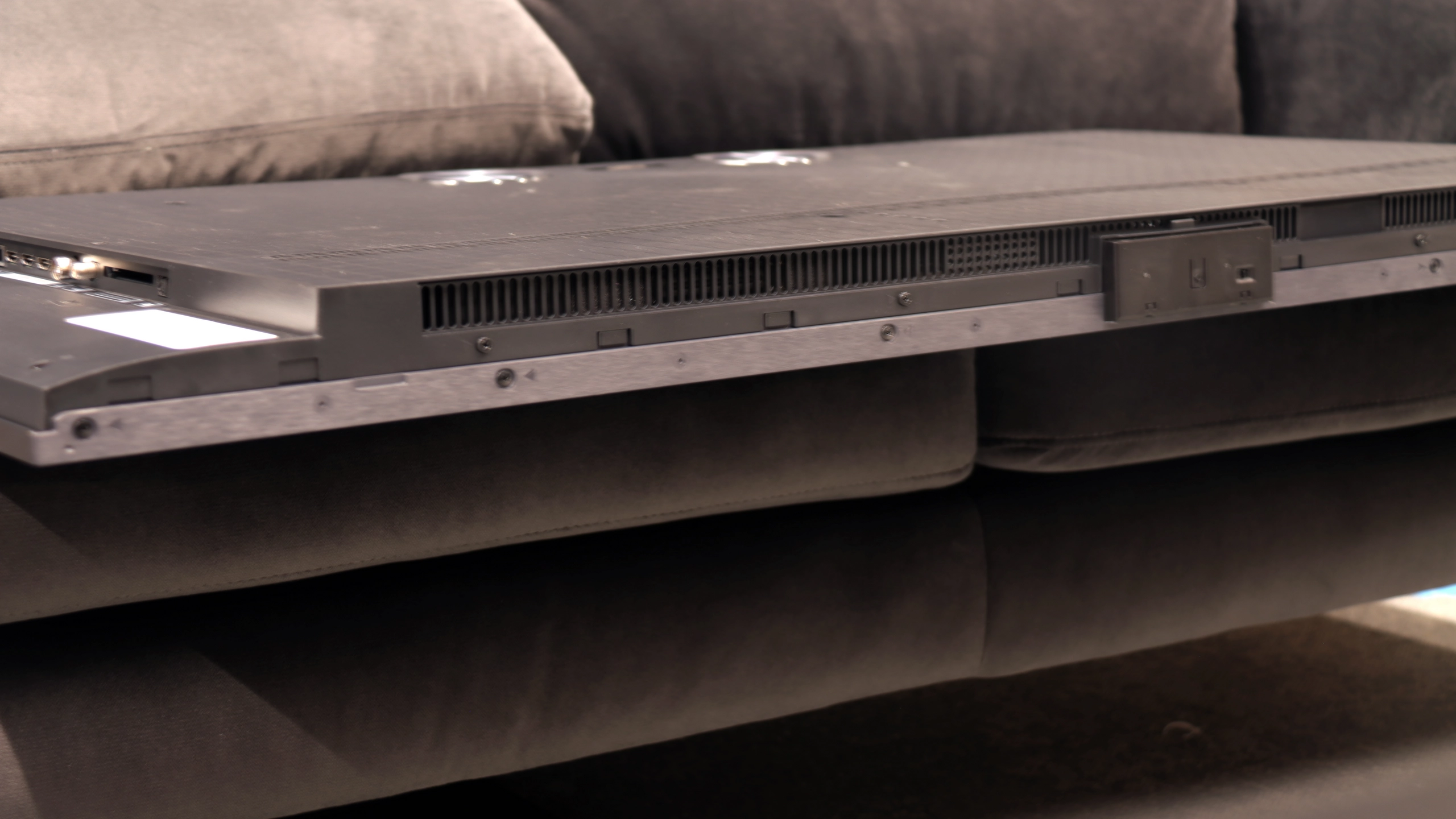


In the larger versions of the C7K (from 55 inches and above), the sound makes an even better impression than in the smallest 50-inch variant. This is due to the greater number of built-in speakers and additional channels, which allow for a fuller, more spatial sound. The bass becomes clearer, dialogues gain clarity, and the film effects can really fill the room.
It's worth mentioning the collaboration between TCL and Bang & Olufsen, which appeared in the 2025 models. Even if we don't have a hundred percent certainty that original Danish company drivers are working inside, the final effect is surprisingly positive. For a television without an additional soundbar, the larger C7K models offer sound that can be enjoyed even during longer movie sessions.
Sound Quality Test:
Acoustic Measurements
No acoustic data
TCL C7K - Panel details
Software version during testing: V8.0012T01-LF1V531.002396
Image processor: MT5896 2,5GB RAM
Subpixel Structure:
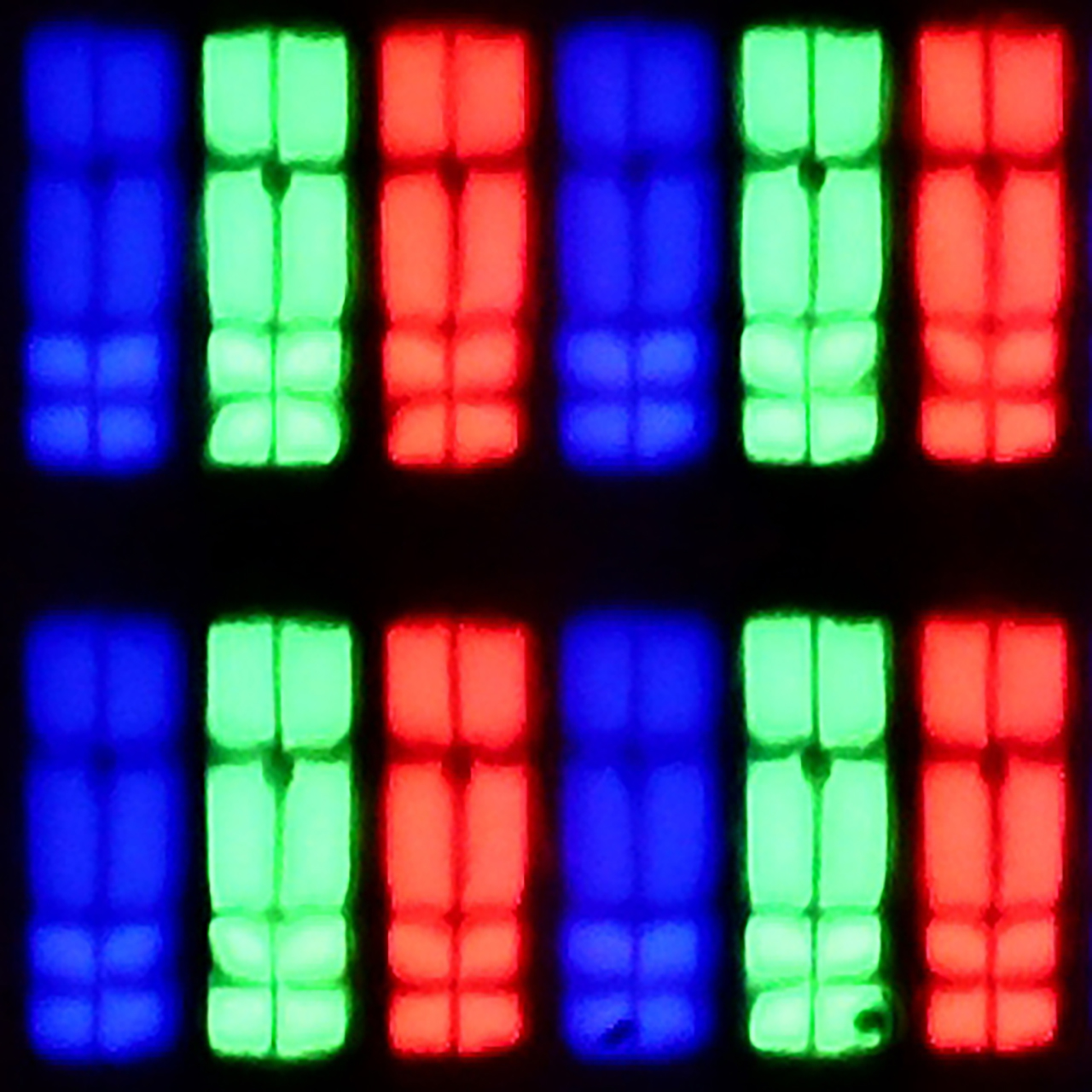
Panel uniformity and thermal imaging:
Backlight Type: Mini-LED QLED

Founder and originator of the "ChooseTV" portal

Journalist, reviewer, and columnist for the "ChooseTV" portal
See articles related to TCL C7K / QM7K 55"-85":
5/13/2025

